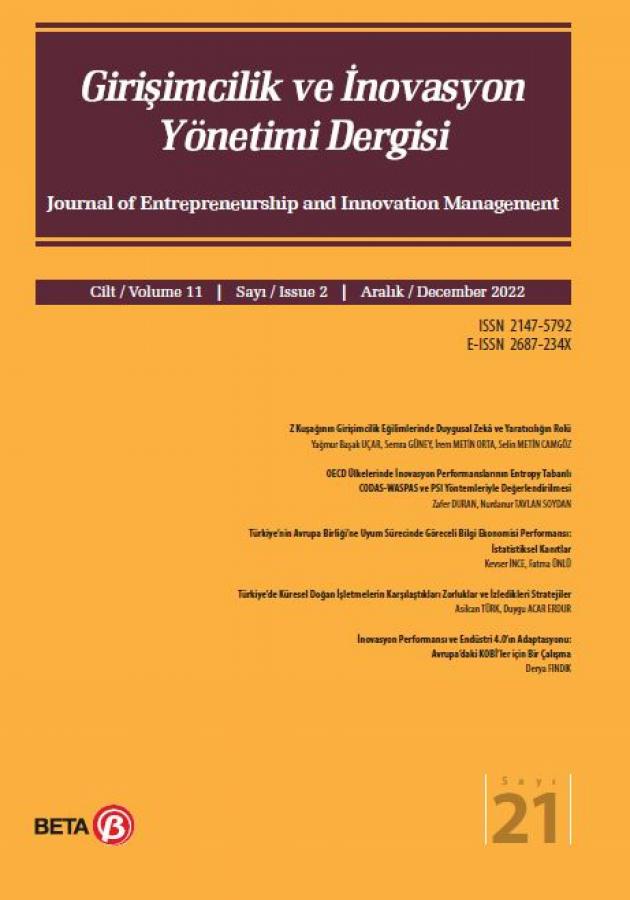3 (2), 2014
[FULL VERSION - PDF]
Dr Joel SOTAMENOU
Corporate social responsibility among small and medium size enterprises in CameroonThis paper aims to evaluate the practice of corporate social
responsibility (CSR) by managers of small and medium size enterprises
(SMEs) in Cameroon. More specifically it aims to analyse the
ecological behaviour of managers of SMEs in Cameroon and identify
the determinants of the adoption of environmental dimension of CSR
(e-CSR) measures in SMEs. Evidence from our analyses points the fact
that the environmental protection is not yet a priority for managers of
SMEs in Cameroon. There are several ways to increase the practice of
e-CSR among SMEs managers, including the presence of an in-house
department in charge of the environment, conducting environmental
impact studies, and acquiring “clean equipment”.
Keywords: Corporate social responsibility, small and mediumsized enterprises, Managers, Adoption, Cameroon
[PDF]
Gender, Innovation and Labour Productivity in Ugandan manufacturing firmsIn this paper, we analyzed the relationship between gender,
innovation and labour productivity in Ugandan manufacturing firms.
An augmented Cobb Douglas production function was estimated using
pseudo panel data. Little was known about the relationship between
gender, innovation and labour productivity in Ugandan manufacturing
firms. The descriptive results showed that manufacturing firms that are
innovative using ICT usage as proxy had on average high levels of labour
productivity than their counterparts. In addition, firms owned by male
entrepreneurs had higher levels of labour productivity compared firms
owned by female entrepreneurs. The regression results did not find any
significant differences in terms of labour productivity between firms
owned by female and male entrepreneurs. ICT usage was shown to be
positively correlated with labour productivity although the correlation
was weak. The results show that gender is not complementary to ICT
usage in improving labour productivity. These findings have vital policy
implications on innovation and gender consideration asa development
strategy.
Keywords: ICT usage, gender, labour productivity, manufacturing firms
[PDF]
Directive Management Style, Motivation, and Innovation Capability in New Product Development ProjectsBased on the global and technological nature of business
environment, hyper-competition has highlighted the need for firms,
particularly those operating in high-tech industries, to rely on
cross-functional new product development (NPD) teams to produce
innovations in a timely manner. Therefore, the ability of NPD teams for
innovation becomes a matter of concern. Innovation ability arises as a
result of the mutual interactions among team members, structure, and
NPD processes. In order to develop as well as to sustain such ability
within NPD context, the motivation level of team members becomes
very crucial. Previous studies revealed that motivation is highly
dependent on the relationships and interactions between the leader and
each team member and between each team member within the NPD
context. However there is still a gap in the literature concerning how
the leadership styles influence a team member’s motivation and how
this given relationship is ultimately reflected on innovation ability.
In this study, we aimed to investigate the influence of the leadership
styles of team leaders on team member’s motivation; as well as to
determine the role of team member motivation on developing innovation
ability. Based on the fact that this study is conducted on NPD context,
we also explored the potential moderator effect of project complexity on
the relationship between the team member motivation and innovation
ability. Partial least squares structural equation modeling (PLS-SEM)
methodology was employed on the sample size of 145 NPD team
members’ data. we found that (i) the directive management style of the
NPD team leaders are associated with higher levels of both internal and
external motivation of team members, (ii) the higher level of external
motivation of team members result with a proficiency in the ability to
innovate, and (iii) the higher the project complexity the stronger the
relationship between internal motivation and the innovative capability.
Implications for both theory and practice were discussed.
Keywords: New product development, directive management style, motivation, innovation capability
[PDF]
A Bibliometric Evaluation Concerning the Strategic Entrepreneurship FieldThis study applies a literature-based analysis in its discussion
of the research field of strategic entrepreneurship. It uses bibliometric
techniques (Citation analysis) as its primary research method to present
a general picture of the strategic entrepreneurship research. Paper covers
123 research articles published in the Strategic Entrepreneurship Journal
between 2007-2013.Upon observing the citation analysis and evaluation
of topics that result, it becomes clear that the research on strategic
entrepreneurship is influenced by both the scientific fields of economics,
competition, strategic management, and the topics of resource-based
theory, organizational behaviour, innovation and learning.
Keywords: Strategic Entrepreneurship, Bibliometrics, Citation Analysis.
[PDF]
Port Innovations and Information Systems: A Research on Turkish PortsThis study aims to identify the port innovations adopted and to
reveal the effects of port information systems usage on port innovations.
In accordance with the aim, a field study encompassing a sample
of 39 Turkish ports was employed. The results showed that since the
usage of port management information systems and terminal operating
systems by Turkish ports has been accelerated in the recent years, the renewal of port information systems did not appear as a priority for the
ports. The results revealed that port innovations employed are concentrated
on eco-innovations, technological (equipment) innovations and
port service innovations. Results supported all of the five hypotheses.
An important finding was that port traffic type impacts the adoption of
port innovations. Besides, it has been found out that while the usage of
terminal operating systems has impacts on operational process innovations;
the usage of port community information systems has effects on
port service innovations.
Keywords: Port Innovation, Eco-innovation, Port Management Information System, Terminal Operations System, Port Community Information System.
[PDF]


